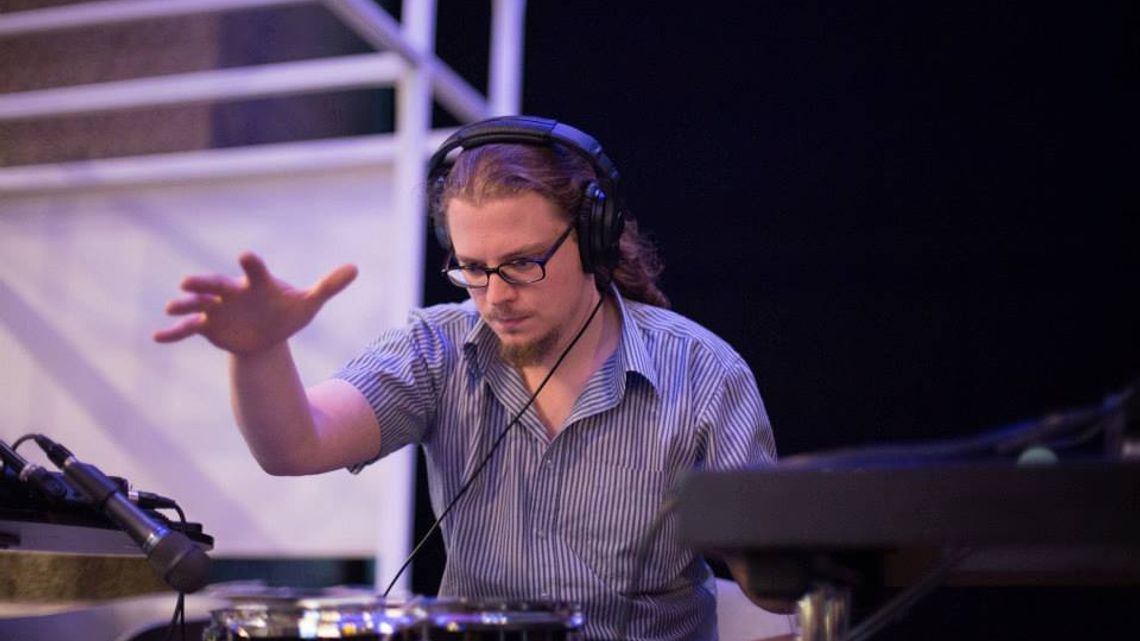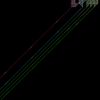
Drumactica 2.0 is a solo, augmented percussion set up, created the Hack the Barbican, London.
The piece, which evolves from Drumactica, is the creative bond between the desire to improve melodic and harmonic contours of the snare drum, and the concept of an embodied music performance.
Drumactica 2.0 started as a composition for an array of augmented percussive tools. I started by modifying the MakeyMakey code, through the Arduino software, changing all its outputs to letters. As this tutorial explains in very simple terms, you just need to add letters between inverted commas (i.e. 'a') and you have your new output. I tried to exploit all the keys that send notes to Ableton from the computer keyboard. I am rather certain that the MakeyMakey can send MIDI messages, bypassing this 15 letters limitation, but it's currently beyond my technical knowledge.
I augmented the snare drum by attaching a strip board and sending six cables inside the shell, to pierce the head and bring the signal to the surface of the instrument. Through a mixture of acrylic and conductive ink, my lovely girlfriend Oriana Lauria created a breakfast plate. When touched, the conductive outlines of the various shapes closed the circuit and send the signal to the boards.
Even though the snare lost some of its acoustic charm, due to all these holes and muffling material, I particularly enjoyed improvising with brushes; their metal tips and bottoms are too conductive and allow the performer to either play acoustically or interact with the attached VSTs.
A few more commonplace objects further augmented the setup. I pierced through the soft silicon bottom of an ice-cube tray, creating a water piano that could control my arpeggiators. I also wrapped two toy tennis rackets in tin foil and started using them as pedals.
The acoustic part of the composition was very important because the MakeyMakey did not allow for any dynamic (velocity) control, which I had when using knock sensors (piezo) or Arduino setups. Furthermore, this new instrument allowed me to control the length of the notes. As a percussionist, this was just a dream! Most of the acoustic instruments (except vibraphone, glockenspiel and tubular bells) have no easy and precise control over the length of the note. Playing with rhythm and long pedals had an incredible potential for the improvisatory process, at the origin of Drumactica 2.0.
Luckily enough, the LeapMotion was released just a week before my performance, and I integrated it into the setup through GecoMIDI. This app allows the user to send MIDI cc messages, which can be mapped to any continuous control within Ableton. The process was laborious but intuitive; in a few hours I was mapped my setup in full.
The Leap Motion boosted the expressiveness control and humanized the digital sounds to a surprising extent. I found quite difficult and risky to perform with it, away from the computer but, with some practice, one can handle the imaginary positions in space.
The MIDI data was handled in an Ableton Live!8 environment. Each sensor was isolated and sent to a different channel via IAC driver buses. I did this to control the pitch output. The key problem of this instrument is that each connection always produce the same note. Together with digital composer Mr. David Ibbett, I designed a patch that can modify the incoming note, filtering it through another source. If I had a constant C in input, I could play a series of notes on my other MIDI controller - a launchpad on this occasion - and have the original signal to cycle through these new series. I often put a chord generator after this patch, called serialiser, to boost the polyphony. The chord parameters were assigned to the cc messaging and, by moving one hand (roll, yaw and all the other 3D movements) I could control the harmonic content.
The instrument I came up with, reflected my interests towards the embodiment of the music. Since the early days of my percussion instruments studies, it became obvious how ancillary gestures were fundamental for both a good technique and sound production, and for an engaging audio/visual performance. I incorporated more and more of these movements in my music theatre performances of pieces by Aperghis, Globokar, among others, even directing them towards imaginary instruments, like in Homework II by François Sarhan. Initially, I amplified these gestures by carefully positioning floor lights during the performance, creating an interesting shadow play. With Leap Motion, for the first time, I had the chance to exploit these movements to physically manipulate the sound.
This significant step towards the embodiment of sound was matched by the MakeyMakey's organizing principle, which uses one's own body to convey the electric signal and produce data.
As a percussionist, I owe a lot to John Cage for his achievements on the emancipation of noise and the elevation of objects to musical instruments. With this branch of research I am trying to blur the even deeper distinction between the human performer and the sound controller. This ache for a complete embodiment, strives for a re-invention of the performative act; the creation of a continuum between body and object, for the production and control of a new imaginary landscape.
The piece, which evolves from Drumactica, is the creative bond between the desire to improve melodic and harmonic contours of the snare drum, and the concept of an embodied music performance.
Drumactica 2.0 started as a composition for an array of augmented percussive tools. I started by modifying the MakeyMakey code, through the Arduino software, changing all its outputs to letters. As this tutorial explains in very simple terms, you just need to add letters between inverted commas (i.e. 'a') and you have your new output. I tried to exploit all the keys that send notes to Ableton from the computer keyboard. I am rather certain that the MakeyMakey can send MIDI messages, bypassing this 15 letters limitation, but it's currently beyond my technical knowledge.
I augmented the snare drum by attaching a strip board and sending six cables inside the shell, to pierce the head and bring the signal to the surface of the instrument. Through a mixture of acrylic and conductive ink, my lovely girlfriend Oriana Lauria created a breakfast plate. When touched, the conductive outlines of the various shapes closed the circuit and send the signal to the boards.
Even though the snare lost some of its acoustic charm, due to all these holes and muffling material, I particularly enjoyed improvising with brushes; their metal tips and bottoms are too conductive and allow the performer to either play acoustically or interact with the attached VSTs.
A few more commonplace objects further augmented the setup. I pierced through the soft silicon bottom of an ice-cube tray, creating a water piano that could control my arpeggiators. I also wrapped two toy tennis rackets in tin foil and started using them as pedals.
The acoustic part of the composition was very important because the MakeyMakey did not allow for any dynamic (velocity) control, which I had when using knock sensors (piezo) or Arduino setups. Furthermore, this new instrument allowed me to control the length of the notes. As a percussionist, this was just a dream! Most of the acoustic instruments (except vibraphone, glockenspiel and tubular bells) have no easy and precise control over the length of the note. Playing with rhythm and long pedals had an incredible potential for the improvisatory process, at the origin of Drumactica 2.0.
Luckily enough, the LeapMotion was released just a week before my performance, and I integrated it into the setup through GecoMIDI. This app allows the user to send MIDI cc messages, which can be mapped to any continuous control within Ableton. The process was laborious but intuitive; in a few hours I was mapped my setup in full.
The Leap Motion boosted the expressiveness control and humanized the digital sounds to a surprising extent. I found quite difficult and risky to perform with it, away from the computer but, with some practice, one can handle the imaginary positions in space.
The MIDI data was handled in an Ableton Live!8 environment. Each sensor was isolated and sent to a different channel via IAC driver buses. I did this to control the pitch output. The key problem of this instrument is that each connection always produce the same note. Together with digital composer Mr. David Ibbett, I designed a patch that can modify the incoming note, filtering it through another source. If I had a constant C in input, I could play a series of notes on my other MIDI controller - a launchpad on this occasion - and have the original signal to cycle through these new series. I often put a chord generator after this patch, called serialiser, to boost the polyphony. The chord parameters were assigned to the cc messaging and, by moving one hand (roll, yaw and all the other 3D movements) I could control the harmonic content.
The instrument I came up with, reflected my interests towards the embodiment of the music. Since the early days of my percussion instruments studies, it became obvious how ancillary gestures were fundamental for both a good technique and sound production, and for an engaging audio/visual performance. I incorporated more and more of these movements in my music theatre performances of pieces by Aperghis, Globokar, among others, even directing them towards imaginary instruments, like in Homework II by François Sarhan. Initially, I amplified these gestures by carefully positioning floor lights during the performance, creating an interesting shadow play. With Leap Motion, for the first time, I had the chance to exploit these movements to physically manipulate the sound.
This significant step towards the embodiment of sound was matched by the MakeyMakey's organizing principle, which uses one's own body to convey the electric signal and produce data.
As a percussionist, I owe a lot to John Cage for his achievements on the emancipation of noise and the elevation of objects to musical instruments. With this branch of research I am trying to blur the even deeper distinction between the human performer and the sound controller. This ache for a complete embodiment, strives for a re-invention of the performative act; the creation of a continuum between body and object, for the production and control of a new imaginary landscape.
Duration (minutes)
13
What is needed
Drum stool (or chair without armrests)
Small stand for snare drum
Microphone stand
2 small tables (big enough to fit a laptop each)
1 power socket
2 balanced 1/4" Jacks for connection to the PA system
I will provide the remaining materials, including augmented snare drum, various PCB boards and laptop.
